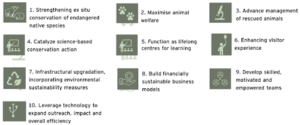In news- Recently, the Ministry of Environment, Forest, and Climate Change has released the Vision Plan (2021-2031) for Indian zoos.
Key features of the Vision plan 2021- 2031-
- Vision Plan is a strategy of transformation for Indian zoos that lays out a roadmap for change.
- The Plan aims to give a direction towards ex-situ conservation approaches in India.
- The plan is committed to making Indian zoos a greater force for conservation by providing unparalleled animal care, cutting edge research, and immersive visitor experiences that strike meaningful chords with people of all ages
- While the Vision Plan aims to upgrade Indian zoos to global standards, the focus is on conserving local birds and animals.
- The 10-year plan is directed towards improving the visitor experiences of people of all ages.
- It aims towards upgrading Indian zoos to global standards and strengthening of the Central Zoo Authority (CZA).
- The other goal is to make CZA and other Indian zoos a stronger force for the conservation of animals and birds by providing unparalleled animal care, cutting-edge research.
Pillars of change-
The plan echoes the following ‘Pillars of Change’ anchored across goals of conservation breeding, animal welfare, scientific research, visitor experience and education, sustainability, elevated teams and technology driven institutions, for CZA as well as zoos.

Each Pillar of Change will be realised through specific initiatives that ‘Calls for Action’ to key stakeholders (CZA and Zoos). The plan also chalks out specific targets and timelines for these ‘Call to Action’ to be realised across a period of 10 years.
About Central Zoo Authority(CZA)-
- In 1991, the Indian Parliament enacted the amendment of the Wildlife (Protection) Act, which provided for the enforcement of mandatory standards and norms for management of zoos through the Central Zoo Authority.
- The CZA is a statutory body chaired by the Environment Minister and tasked with regulating zoos across the country.
- It lays down guidelines and prescribes rules under which animals may be transferred among zoos nationally and internationally.
- Apart from the chairman, it consists of 10 members and a member-secretary.
- Almost all of them are officials in the Environment Ministry and non-government experts are those who are wildlife conservationists or retired forest officers.
- The main objective of the Authority is to complement and strengthen the national effort in conservation of the rich biodiversity of the country, particularly the fauna as per the National Zoo Policy, 1998.
- Other objectives of this Authority include enforcing minimum standards and norms for upkeep and healthcare of animals in Indian zoos and to control mushrooming of unplanned and ill conceived zoos.
- Every zoo in the country is required to obtain recognition from the Authority for its operation.
- The role of the Authority is more as a facilitator than as a regulator.
















